建筑遗产保护课件一
- 格式:doc
- 大小:68.50 KB
- 文档页数:4
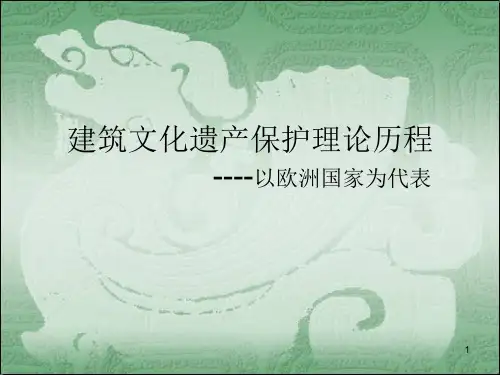
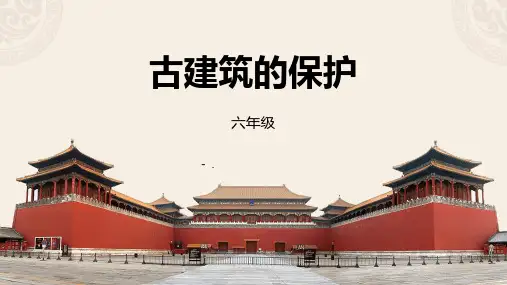
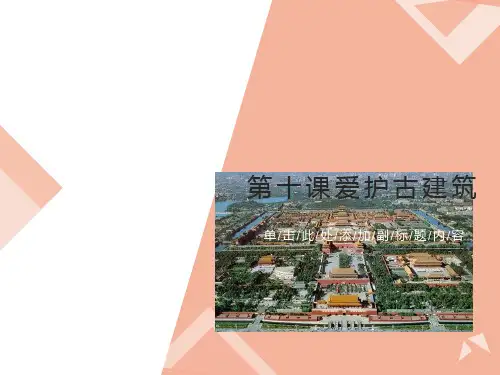
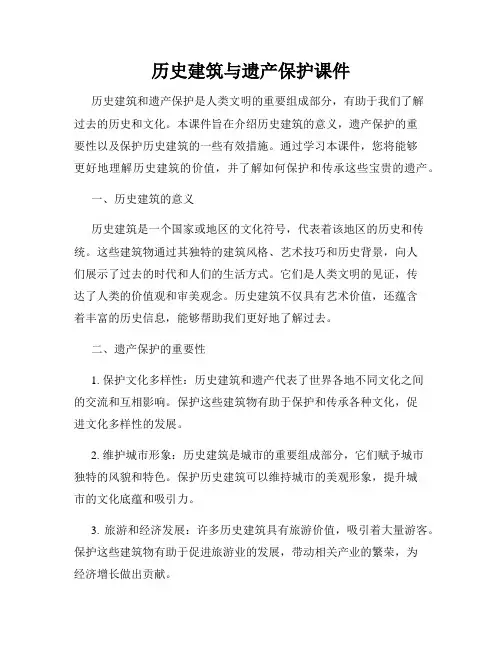
历史建筑与遗产保护课件历史建筑和遗产保护是人类文明的重要组成部分,有助于我们了解过去的历史和文化。
本课件旨在介绍历史建筑的意义,遗产保护的重要性以及保护历史建筑的一些有效措施。
通过学习本课件,您将能够更好地理解历史建筑的价值,并了解如何保护和传承这些宝贵的遗产。
一、历史建筑的意义历史建筑是一个国家或地区的文化符号,代表着该地区的历史和传统。
这些建筑物通过其独特的建筑风格、艺术技巧和历史背景,向人们展示了过去的时代和人们的生活方式。
它们是人类文明的见证,传达了人类的价值观和审美观念。
历史建筑不仅具有艺术价值,还蕴含着丰富的历史信息,能够帮助我们更好地了解过去。
二、遗产保护的重要性1. 保护文化多样性:历史建筑和遗产代表了世界各地不同文化之间的交流和互相影响。
保护这些建筑物有助于保护和传承各种文化,促进文化多样性的发展。
2. 维护城市形象:历史建筑是城市的重要组成部分,它们赋予城市独特的风貌和特色。
保护历史建筑可以维持城市的美观形象,提升城市的文化底蕴和吸引力。
3. 旅游和经济发展:许多历史建筑具有旅游价值,吸引着大量游客。
保护这些建筑物有助于促进旅游业的发展,带动相关产业的繁荣,为经济增长做出贡献。
4. 保护人类记忆:历史建筑见证了人类的历史发展,它们是我们文明的实物证据。
保护历史建筑有助于保留人类的记忆和个人故事,让后代能够更好地理解和欣赏过去的文化。
三、保护历史建筑的措施1. 法律保护:建立相关法律和法规,保护历史建筑的完整性和安全性。
制定法规,明确历史建筑的保护责任和义务,规定违法行为的法律后果。
2. 维护和修复:对受损的历史建筑进行维护和修复,保持其原貌和独特风格。
在维修过程中,要尽量保留原始建筑材料和工艺,避免对历史建筑造成二次破坏。
3. 教育和宣传:加强公众对历史建筑和遗产保护的认识和意识。
开展各类教育活动,如举办讲座、展览和培训班,提高公众对历史建筑的了解和关注程度。
4. 国际合作:加强国际交流与合作,共同保护和传承世界各地的历史建筑和遗产。
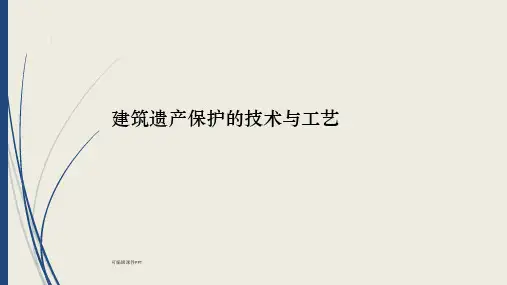
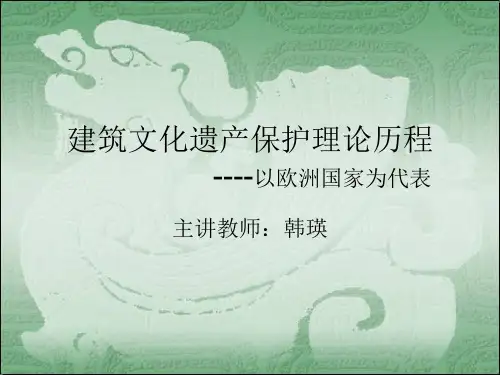
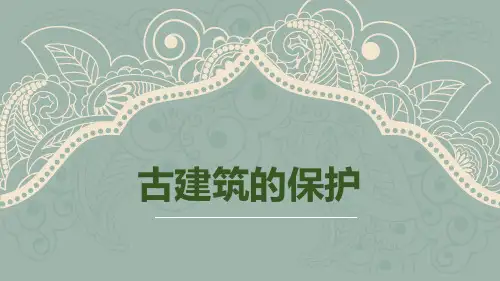
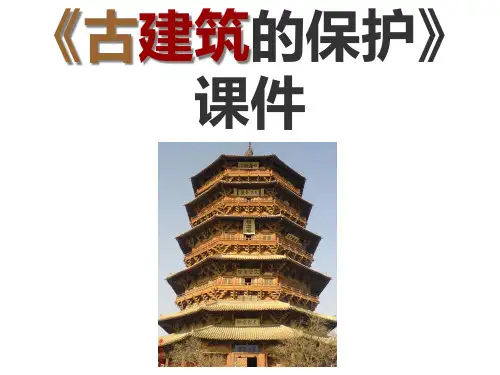
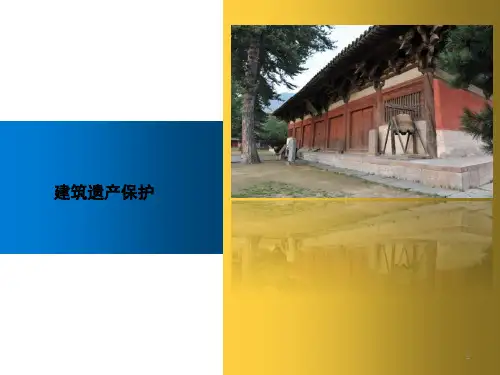

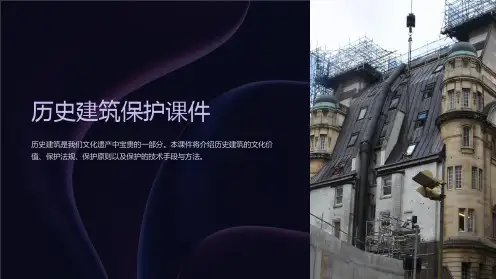
建筑遗产保护课件一一、Architectural Heritage 建筑遗产具有历史一定历史价值和建筑学价值的不可移动的古迹及其环境。
常见相关词汇:文物、古迹、文化遗产、文化财产、文物保护单位文物建筑、历史建筑、古建筑历史环境古城、历史城镇、历史文化名城、历史街区、历史区段、历史文化名区、历史村镇历史园林与景观、风景名胜区历史战场English wordscultural relics, monument, cultural heritage, heritage sites, cultural property, officially protected site/entityhistoric setting / environmentancient city, historic town, historic block, conservation area, famous cities of historical and cultural valuehistoric park/gardenhistoric battlefield《文物保护法》归入“不可移动文物”具有历史、艺术、科学价值的古文化遗址、古墓葬、古建筑、石窟寺和石刻、壁画与重大历史事件、革命运动或者著名人物有关的以及具有重要纪念意义、教育意义或者史料价值的近现代史迹、实物、代表性建筑历史文化名城、历史文化街区、村镇sites of ancient culture, ancient tombs, ancient architectural structures, cave temples, stone carvings and murals that are of historical, artistic or scientific value;important modern and contemporary historic sites, material objects and typical buildings that are related to major historical events, revolutionary movements or famous personalities and that are highly memorable or are of great significance for education or for the preservation of historical data;valuable works of art and handicraft articles dating from various historical periods;important documents dating from various historical periods, and manuscripts, books and materials, etc. that are of historical, artistic or scientific value; andtypical material objects reflecting the social system, social production or the life of various nationalities in different historical periods.《中国文物古迹保护准则》定义的“文物古迹”人类在历史上创造或人类活动遗留的具有价值的不可移动的实物遗存包括地面与地下的古文化遗址、古墓葬、古建筑、石窟寺、近现代史迹及纪念建筑、由国家公布应予以保护的历史文化街区(村镇),以及其中的原有的附属文物。
Heritage sites are the immovable physical remains that were created during the history of humankind and that have significance; they include archaeological sites and ruins,tombs, traditional architecture, cave temples, stone carvings, sculpture, inscriptions, stele, and petroglyphs, as well as modern and contemporary places and commemorative buildings, and those historic precincts (villages or towns), together with their original heritage components, that are officially declared protected sites.《威尼斯宪章》中的“历史古迹”历史古迹的概念不仅包含单个建筑物,而且包括能从中找出一种独特的文明、一种有意义的发展或一个历史事件见证的城市或乡村环境。
这不仅适用于伟大的艺术作品,而且亦适用于随时光流逝而获得文化意义的过去一些较为朴实的艺术品。
The concept of an historic monument embraces not only the single architectural work but also the urban or rural setting in which is found the evidence of a particular civilization, a significant development or an historic event. This applies not only to great works of art but also to more modest works of the past which have acquired cultural significance with the passing of time.《世界遗产公约》中的“文化遗产”文化遗产包括具有突出普遍价值的“古迹、建筑群、遗址”等《操作指南》增加市镇规划和文化景观类型monuments: architectural works, works of monumental sculpture and painting, elements or structures of an archaeological nature, inscriptions, cave dwellings and combinations of features, which are of outstanding universal value from the point of view of history, art or science;groups of buildings: groups of separate or connected buildings which, because of their architecture, their homogeneity or their place in the landscape, are of outstanding universal value from the point of view of history, art or science;sites: works of man or the combined works of nature and man, and areas including archaeological sites which are of outstanding universal value from the historical, aesthetic, ethnological or anthropological point of view.其他公约《佛罗伦萨宪章》、《保护历史城镇和城区宪章》:历史园林、历史街区等等不断扩展的“遗产”概念从建筑、建筑群到街区、城市乃至广阔的文化景观从艺术杰作到平凡的作品从“古建筑” 到年代较近的建筑从有形遗产到无形遗产(非物质遗产)本课程界定的“建筑遗产”范围历史建筑、古迹、建筑群及其不可分割的附属文物(一般不讨论考古遗址)历史城市、城镇、城区、街区历史村镇、民居历史园林、景观现代建筑遗产(包括工业遗产)相关的无形遗产(如传统建筑工艺)二、建筑遗产的价值Values of Architectural Heritage文物价值、历史价值、艺术价值、科学价值(art. 3, PC HSC) The heritage values of a site comprise its historical, artistic, and scientific values.社会价值实用价值精神上的信仰、认同、寄托和象征(宗教、礼仪、民俗等)审美愉悦认识世界、学术研究知识传播、文化传承(教育)旅游和经济发展三、保护的概念Concepts of Conservation保护的概念:保护是指为保存文物古迹实物遗存及其历史环境进行的全部活动。
保护的目的是真实、全面地保存并延续其历史信息及全部价值。
保护的任务是通过技术的和管理的措施,修缮自然力和人为造成的损伤,制止新的破坏。
所有保护措施都必须遵守不改变文物原状的原则。
Conservation refers to all measures carried out to preserve the physical remains of sites and their historic settings.The aim of conservation is to preserve the authenticity of all the elements of the entire heritage site and to retain for the future its historic information and all its values.Conservation in practice involves treatment of damage caused by natural processes and human actions and prevention of further deterioration, using both technical and management measures.All conservation measures must observe the principle of not altering the historic condition.相关词汇保护、保存、保全、保育干预、修复、加固、维修、修缮、复原、复建、维护、保养、整治更新、利用Safeguard, protect (protection), conserve (conservation), preserve (preservation), keep Intervene (intervention), restore (restoration), repair, consolidate, alter, renovate, change, modify, adapt, demolish, pull downrebuild, reconstruct, recreate, re-erect,reassemble, anastylosismaintain (maintenance), take care, look after, reuse, re-habitation保护相关工作的内容法律、政策和行政保障Law and policy遗产的调查、研究和评估Investigation, research and assessment制定保护名录Inventory记录和建档Recording/Documentation, Archiving (information management)保护规划Conservation Planning保护工程Conservation engineering展示宣传和普及教育Interpretation and presentation专业培训professional training日常管理维护daily maintenance and management保护相关工作的内容历史环境的保护conservation of historic environment旧建筑改造利用rehabitation of old buildings新建筑与旧建筑relation between new and old buildings城市整体保护、利用和更新integrated urban conservation, utilization and renovation 遗产保护的特点紧迫性自然与人为破坏;保护与发展的矛盾专业性技术要求高,需资质合格的相应专业人才综合性多专业、跨学科;多部门多样性木质文物、石质文物 古代、近现代 不同所有制管理、利用方式不同课程涵盖的内容建筑遗产保护简史建筑遗产的保护理念国内法律法规体系建筑遗产认定、研究和评估 建筑遗产的记录和建档保护规划保护工程历史城市的保护和有机更新四、我们的工作Our achievements测绘实习以测绘为基础的研究工作保护规划和保护工程项目(甲级设计资质) 国家文物局文物建筑测绘研究基地专门化教育五、参考文献和资源Reference and Resources中文参考书目:罗哲文主编:中国古代建筑中国古建筑修缮技术祁英涛:中国古代建筑的保护与维修文物保护工程典型案例建筑与历史环境历史文化名城保护理论与规划历史城市保护学导论国际保护文化遗产法律文件选编中国城市规划设计研究院规划理论与历史名城规划研究所:国外历史城镇与地段保护法规选编中华人民共和国文物保护法中国文物古迹保护准则(案例阐释版)陈志华:意大利古建筑散记在城市上建造城市:法国城市历史遗产保护实践当代英国建筑遗产保护王军城记六、结课办法论文 小设计 调查测绘注:郭美琦整理文字版,原始资料来源天大研究生院E-learn平台“建筑遗产保护”课程资料2011/3/1。